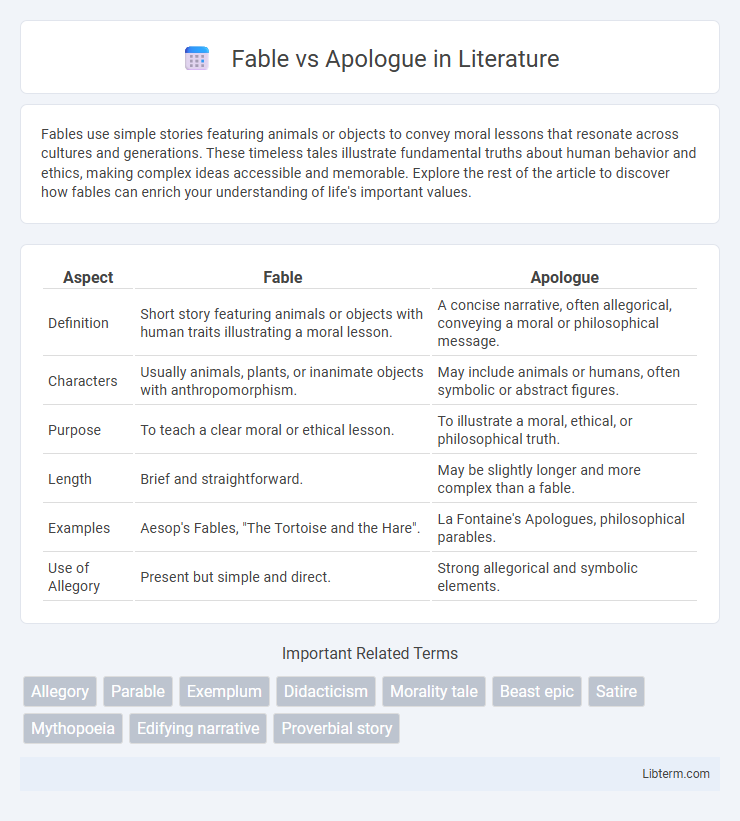Fables use simple stories featuring animals or objects to convey moral lessons that resonate across cultures and generations. These timeless tales illustrate fundamental truths about human behavior and ethics, making complex ideas accessible and memorable. Explore the rest of the article to discover how fables can enrich your understanding of life's important values.
Table of Comparison
| Aspect | Fable | Apologue |
|---|---|---|
| Definition | Short story featuring animals or objects with human traits illustrating a moral lesson. | A concise narrative, often allegorical, conveying a moral or philosophical message. |
| Characters | Usually animals, plants, or inanimate objects with anthropomorphism. | May include animals or humans, often symbolic or abstract figures. |
| Purpose | To teach a clear moral or ethical lesson. | To illustrate a moral, ethical, or philosophical truth. |
| Length | Brief and straightforward. | May be slightly longer and more complex than a fable. |
| Examples | Aesop's Fables, "The Tortoise and the Hare". | La Fontaine's Apologues, philosophical parables. |
| Use of Allegory | Present but simple and direct. | Strong allegorical and symbolic elements. |
Introduction to Fable and Apologue
Fables are short stories that use animals or inanimate objects as characters to convey moral lessons, often featuring clear ethical teachings and anthropomorphic traits. Apologues similarly deliver moral or practical lessons through allegorical narratives but tend to be more elaborate and philosophical in nature, sometimes involving human characters as well. Both genres serve as educational tools, yet fables emphasize simplicity and direct morals, while apologues explore complex ideas through symbolic storytelling.
Defining Fable: Key Characteristics
A fable is a short narrative that uses anthropomorphic animals or inanimate objects to convey a moral lesson, often concluding with a clear, explicit moral statement. It emphasizes simplicity and brevity, making complex ethical ideas accessible through engaging storytelling. Fables typically feature universal themes such as honesty, kindness, and prudence, serving both educational and entertainment purposes.
Defining Apologue: Key Characteristics
An apologue is a succinct allegorical narrative designed to convey a moral lesson, often employing anthropomorphized animals or inanimate objects as characters. This literary form emphasizes simplicity and directness to make ethical teachings accessible and memorable. Unlike fables, apologues may present more complex philosophical or practical issues, aiming to provoke critical reflection beyond straightforward morals.
Origins and Historical Background
Fables originated in ancient oral traditions, with Aesop's Greek tales dating back to the 6th century BCE, serving as a foundational example of this concise storytelling form that imparts moral lessons through anthropomorphic animals. Apologues, rooted in classical literature and Eastern philosophies, particularly Indian and Persian storytelling traditions, emerged as allegorical narratives designed to convey ethical or philosophical messages using symbolic characters and scenarios. Both forms evolved to educate and entertain, reflecting the cultural values and societal norms of their respective historical contexts.
Structural Differences Between Fable and Apologue
Fables typically feature anthropomorphic animals or objects serving as characters to illustrate a moral lesson, whereas apologues often present human characters and focus on practical ethical or philosophical issues. The structure of a fable is concise with a clear beginning, middle, and end, culminating in an explicit moral statement, while apologues employ a more elaborate narrative framework with dialogue and reasoning to persuade the audience. Fables use simple plotlines ideal for teaching children, whereas apologues target a mature audience through complex arguments embedded in the story.
Use of Characters: Animals vs Humans
Fables predominantly use animals as main characters endowed with human traits to convey moral lessons, making the message accessible and relatable across cultures. Apologues, in contrast, often feature human characters or a mix of humans and animals, focusing more on realistic scenarios to illustrate ethical principles. The choice of animals in fables symbolizes universal virtues and vices, while human characters in apologues emphasize specific societal behaviors.
Moral Lessons: Directness and Delivery
Fables convey moral lessons through straightforward, often explicit statements, making the intended message clear and easily understood by all audiences. Apologues deliver moral lessons more subtly, using allegory and nuanced storytelling to encourage reflection and interpretation. This difference in directness and delivery affects how readers internalize and apply the ethical teachings in each genre.
Purpose and Intended Audience
Fables are short stories that use animals or inanimate objects as characters to convey moral lessons primarily aimed at children, emphasizing simple ethical teachings. Apologues, often more complex and allegorical, target an adult or broader audience, focusing on imparting philosophical or practical wisdom through storytelling. Both serve educational purposes, but fables prioritize clarity and accessibility for young readers, while apologues engage a more mature audience with layered meanings.
Notable Examples of Fables and Apologues
Notable examples of fables include Aesop's "The Tortoise and the Hare" and La Fontaine's "The Fox and the Grapes," both illustrating moral lessons through animal characters. Apologues, such as Voltaire's "Candide" and Rudyard Kipling's "The Elephant's Child," convey ethical principles using allegory and metaphor, often with humanized animals or symbolic narratives. These literary forms serve as concise, instructive stories rooted in cultural traditions and philosophical teachings.
Choosing Between Fable and Apologue in Storytelling
Choosing between a fable and an apologue in storytelling depends on the desired moral clarity and narrative style; fables use simple, often animal characters to deliver clear, universal lessons suitable for all ages. Apologues, while also moral tales, typically involve more complex situations or human characters, allowing for nuanced ethical exploration and deeper philosophical reflection. Writers select fables for straightforward ethical instruction and apologues for engaging readers in critical thinking through subtle moral dilemmas.
Fable Infographic

 libterm.com
libterm.com